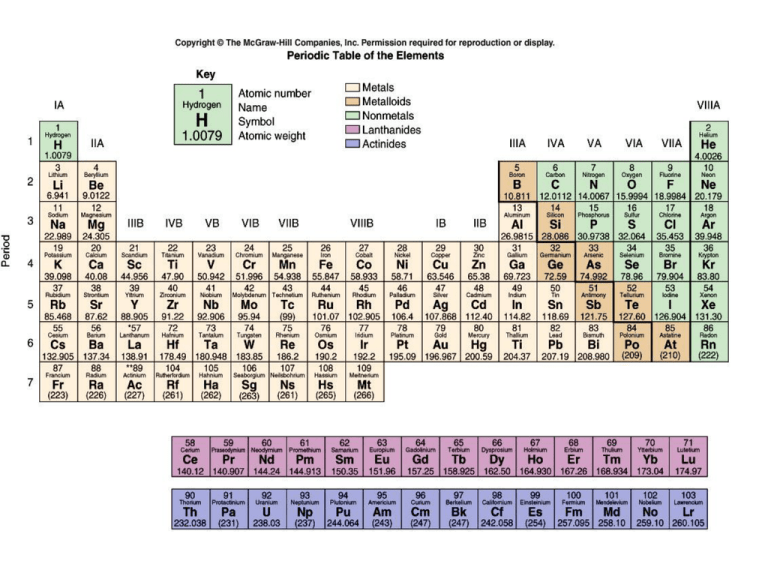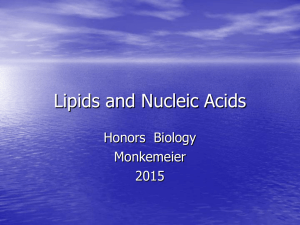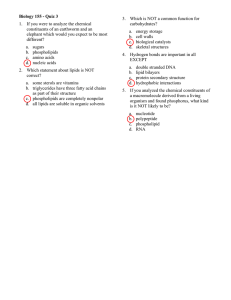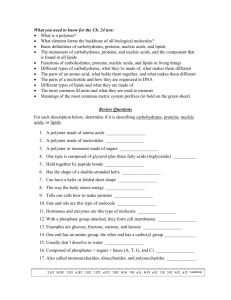Document 15676236
advertisement

What is Organic Chemistry? The study of hydrocarbons = Compounds of hydrogen and carbon 7 million Organic Compounds = Animals and plants, Foods, Clothing Pharmaceuticals, Cosmetics, Fertilizers, Plastics, Petrochemicals (Oil+gas+coal) The Versatile Carbon Atom • Carbon has 4 electrons in outer shell • Can form a bond with four other molecules Carbon is 45% of a plants dry weight Glucose is a sugar made during photosynthesis PHOTOSYNTHESIS makes Sugar RESPIRATION burns Sugar ORGANIC MOLECULES • Organic Molecules all contain CARBON + HYDROGEN • Molecules include: –CARBOHYDRATES –LIPIDS –PROTEINS –NUCLEIC ACIDS CARBOHYDRATES • SUGARS = Fuel for cells • ALCOHOLS = sugars with an -OH • STARCH = plant energy storage • CELLULOSE = plant structure + support • GLYCOGEN = short term animal energy storage Monosaccharides = Simple sugars Theses molecules are linear when dry Or as Rings when hydrated Their Chemical Formulas CARBOHYDRATES = C+H 2 Monosaccharides are joined together by Enzymes to make a Disaccharide Sugar (natural + artificial) Sweetness Chart Cellulose for plant structures Sugars for energy Starches are long chains of glucose Cellulose are also long chains of glucose, but every other glucose is linked upside down, making it stronger and digestible only by microbes "Mutual beneficial" relationship of termiteprotozoa goes back 100 million years Similarly, inside the cow forestomach, there are millions of bacteria, protozoa, and fungi which produce enzymes capable of breaking down cellulose. Lignin and Phenolics are also Complex Carbohydrates About 25- 35% of wood is Lignin (from xylem 2’ walls) Flavonoids can be pigments, but have many other functions. Some are released by plant roots (like peas) to help symbiotic N-fixing bacteria to find + enter the roots. Flavanoids are also known as antioxidants The Carbon Cycle LIPIDS What are Lipids? • • • • • Lipids are Fats, Oils, Waxes, Steroids FATS are : Glycerol + 3 Fatty Acids Lipids are HYDROPHOBIC Not very soluble (dissolvable) in water Three types: (generally) • Triglycerides – energy storage • Phospholipids -membranes • Sterols - hormones Phospholipids make up the lipid bilayer of membranes. They are made of glycerol (an alcohol) + 3 fatty acids (long carbon chains) Phospholipids have 2 carbon chains + a phosphate “head” Phospholipids are what all cell membranes and most cell compartments are made from. They are like “magical walls” and semi-permiable. Phospholipids, waxes, and steroids are lipids with a variety of functions • Phospholipids are a major component of cell membranes • Waxes form waterproof coatings • Steroids are often hormones Figure 3.9 Foxglove flowers have a potent hormone that speeds up the heart rate and is a strong medicine. PROTEINS Protein Functions (Why are proteins important in foods?) • Structural: tendons, ligaments • CONTRACTILE : muscles • • • • • • Enzymes: control chemical reactions Hormones (some are lipids too) Antibodies: immune function Blood proteins: Fluid balance Membranes: transport functions Source of energy Protein in foods • • • • • • • meats, poultry, and fish legumes (dry beans and peas) tofu eggs nuts and seeds milk and milk products grains, some vegetables, and some fruits (provide only small amounts of protein relative to other sources) There are 20 “essential” amino acids. They combine to make proteins. Recommended Dietary Allowance for Protein Grams of protein needed each day • • • • • • • Children ages 1 – 3 Children ages 4 – 8 Children ages 9 – 13 Girls ages 14 – 18 Boys ages 14 – 18 Women ages 19 – 70+ Men ages 19 – 70+ 13 19 34 46 52 46 56 Amino Acids have both an AMINO Group + a CARBOXYL Group attached to a Carbon Your 20 Amino Acids Chemical Structures. Only the R-branch off the carbon center is different. Proteins all have unique functions, determined by their shapes. Enzymes are proteins that catalyze chemical reactions in cells Each has a unique 3-D shape, defined by its amino acid chain DNA is made of NUCLIOTIDES NUCLEOTIDES: a phosphate group + sugar + base (with nitrogen) DNA is the reference copy of genetic information stored in the cells nucleus RNA is a message copy of the DNA used to make proteins in the cell. DNA is made of Nucleotides. Nucleotides are made of a sugar, phosphate group, and a nitrogen containing base. The “base” is the genetic alphabet, and the sugar and phosphate group are the “backbone ” DNA DNA The “base” letters A T C and G are the genetic alphabet. Sugars and phosphate groups bind the ATCG’s together to make DNA and the chromosomes ATP is a high energy nucleotide that is the energy currency of a cell. Ultimately, all glucose is broken down to produce ATP. Alkaloids are plant secondary compounds, that chemically are similar to proteins and nucleotides Review: Carbohydrates, Lipids, Proteins + Nucleic Acids Overview of Digestion Metabolism • How can we get energy from foods we eat? • And all the stuff we need for our bodies to grow and function? • Through the food metabolism, we breakdown and rearrange organic molecules! Food Energy = Calories • Calorie – Energy needed to raise 1 g by 1 ºC • Food is in kcal There are 20 “essential” amino acids. They combine to make proteins. https://www.choosemyplate.gov/ SuperTracker/myplan.aspx







